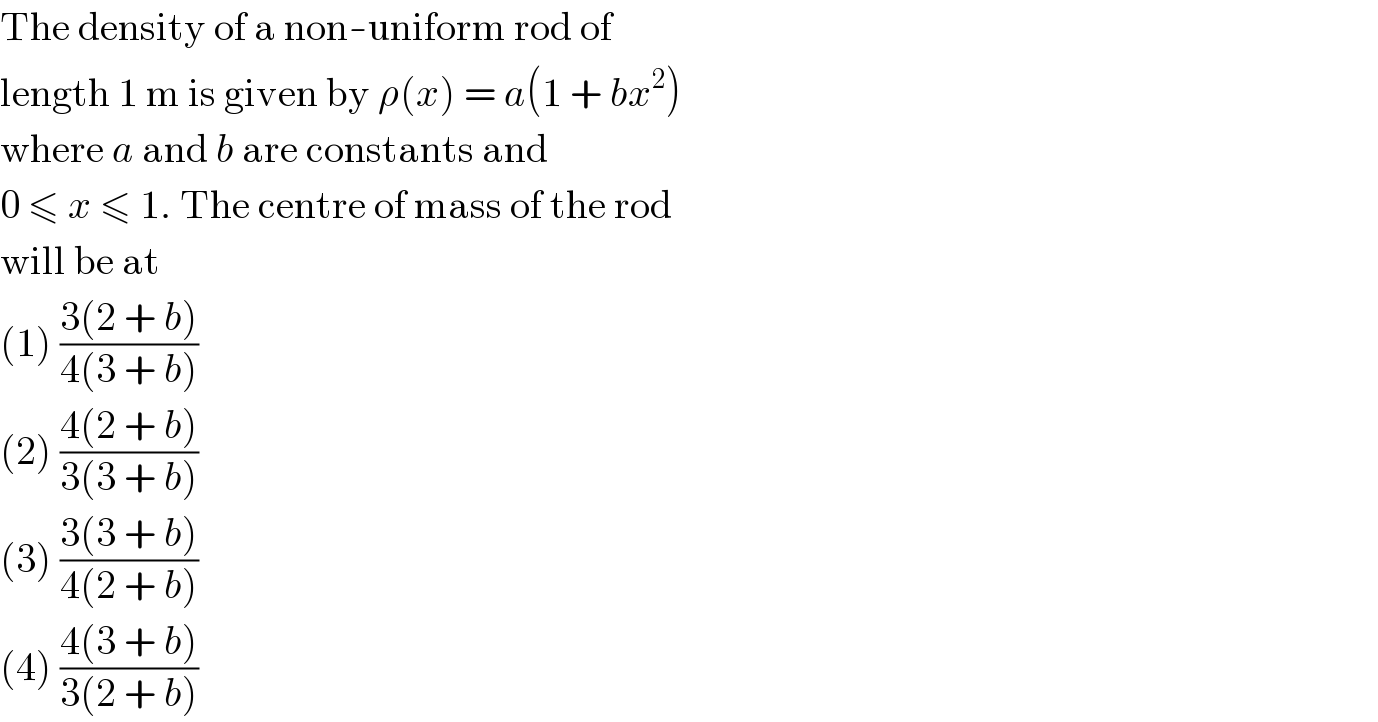
Question Number 24644 by Tinkutara last updated on 23/Nov/17

$$\mathrm{The}\:\mathrm{density}\:\mathrm{of}\:\mathrm{a}\:\mathrm{non}-\mathrm{uniform}\:\mathrm{rod}\:\mathrm{of} \\ $$$$\mathrm{length}\:\mathrm{1}\:\mathrm{m}\:\mathrm{is}\:\mathrm{given}\:\mathrm{by}\:\rho\left({x}\right)\:=\:{a}\left(\mathrm{1}\:+\:{bx}^{\mathrm{2}} \right) \\ $$$$\mathrm{where}\:{a}\:\mathrm{and}\:{b}\:\mathrm{are}\:\mathrm{constants}\:\mathrm{and} \\ $$$$\mathrm{0}\:\leqslant\:{x}\:\leqslant\:\mathrm{1}.\:\mathrm{The}\:\mathrm{centre}\:\mathrm{of}\:\mathrm{mass}\:\mathrm{of}\:\mathrm{the}\:\mathrm{rod} \\ $$$$\mathrm{will}\:\mathrm{be}\:\mathrm{at} \\ $$$$\left(\mathrm{1}\right)\:\frac{\mathrm{3}\left(\mathrm{2}\:+\:{b}\right)}{\mathrm{4}\left(\mathrm{3}\:+\:{b}\right)} \\ $$$$\left(\mathrm{2}\right)\:\frac{\mathrm{4}\left(\mathrm{2}\:+\:{b}\right)}{\mathrm{3}\left(\mathrm{3}\:+\:{b}\right)} \\ $$$$\left(\mathrm{3}\right)\:\frac{\mathrm{3}\left(\mathrm{3}\:+\:{b}\right)}{\mathrm{4}\left(\mathrm{2}\:+\:{b}\right)} \\ $$$$\left(\mathrm{4}\right)\:\frac{\mathrm{4}\left(\mathrm{3}\:+\:{b}\right)}{\mathrm{3}\left(\mathrm{2}\:+\:{b}\right)} \\ $$
Answered by mrW1 last updated on 23/Nov/17

$${x}_{{c}} =\frac{\int_{\mathrm{0}} ^{\:\mathrm{1}} {a}\left(\mathrm{1}+{bx}^{\mathrm{2}} \right){xdx}}{\int_{\mathrm{0}} ^{\:\mathrm{1}} {a}\left(\mathrm{1}+{bx}^{\mathrm{2}} \right){dx}} \\ $$$$=\frac{\frac{\mathrm{1}}{\mathrm{2}}+\frac{{b}}{\mathrm{4}}}{\mathrm{1}+\frac{{b}}{\mathrm{3}}}=\frac{\mathrm{3}\left(\mathrm{2}+{b}\right)}{\mathrm{4}\left(\mathrm{3}+{b}\right)} \\ $$$$\Rightarrow{option}\:\left(\mathrm{1}\right) \\ $$
Commented by Tinkutara last updated on 24/Nov/17

$$\mathrm{Thank}\:\mathrm{you}\:\mathrm{Sir}! \\ $$
Answered by jota+ last updated on 23/Nov/17

$${x}_{{C}} =\frac{\int_{\mathrm{0}} ^{\mathrm{1}} {x}\rho\left({x}\right){dx}}{\int_{\mathrm{0}} ^{\mathrm{1}} \rho\left({x}\right){dx}} \\ $$
Commented by Tinkutara last updated on 24/Nov/17

$$\mathrm{Thank}\:\mathrm{you}\:\mathrm{Sir}! \\ $$
